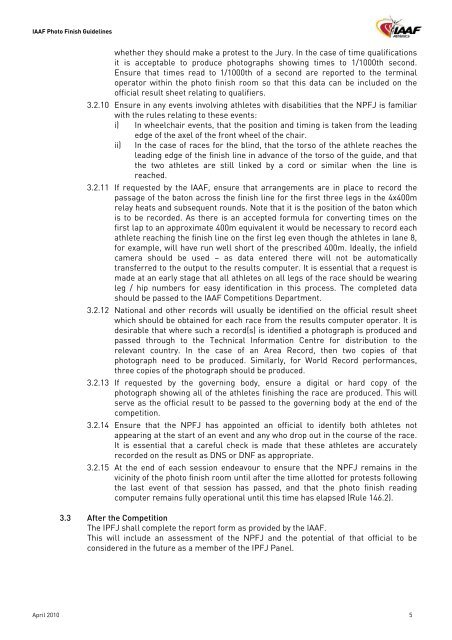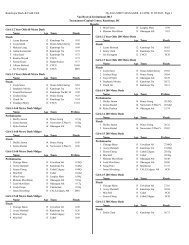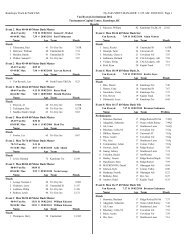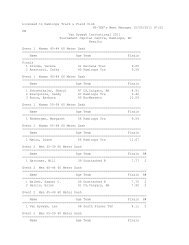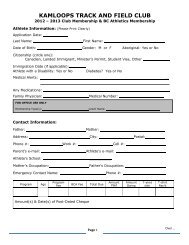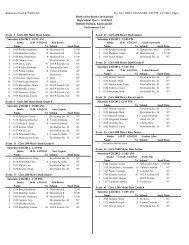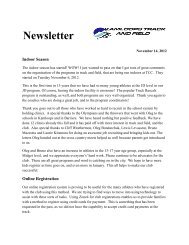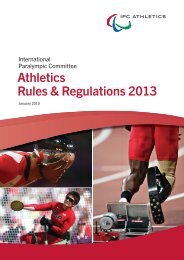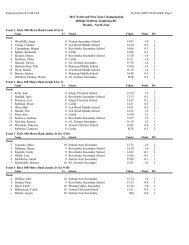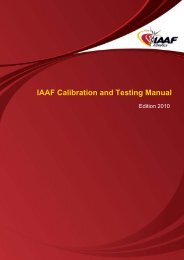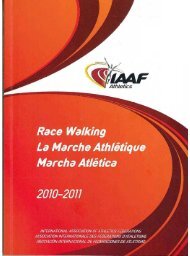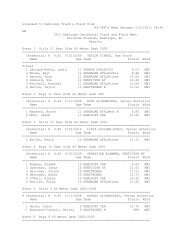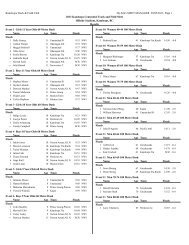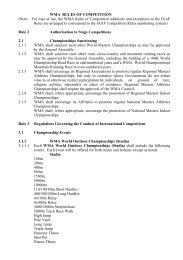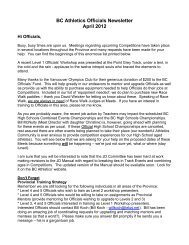IAAF Photo Finish Guidelines
IAAF Photo Finish Guidelines
IAAF Photo Finish Guidelines
Create successful ePaper yourself
Turn your PDF publications into a flip-book with our unique Google optimized e-Paper software.
<strong>IAAF</strong> <strong>Photo</strong> <strong>Finish</strong> <strong>Guidelines</strong><br />
whether they should make a protest to the Jury. In the case of time qualifications<br />
it is acceptable to produce photographs showing times to 1/1000th second.<br />
Ensure that times read to 1/1000th of a second are reported to the terminal<br />
operator within the photo finish room so that this data can be included on the<br />
official result sheet relating to qualifiers.<br />
3.2.10 Ensure in any events involving athletes with disabilities that the NPFJ is familiar<br />
with the rules relating to these events:<br />
i) In wheelchair events, that the position and timing is taken from the leading<br />
edge of the axel of the front wheel of the chair.<br />
ii) In the case of races for the blind, that the torso of the athlete reaches the<br />
leading edge of the finish line in advance of the torso of the guide, and that<br />
the two athletes are still linked by a cord or similar when the line is<br />
reached.<br />
3.2.11 If requested by the <strong>IAAF</strong>, ensure that arrangements are in place to record the<br />
passage of the baton across the finish line for the first three legs in the 4x400m<br />
relay heats and subsequent rounds. Note that it is the position of the baton which<br />
is to be recorded. As there is an accepted formula for converting times on the<br />
first lap to an approximate 400m equivalent it would be necessary to record each<br />
athlete reaching the finish line on the first leg even though the athletes in lane 8,<br />
for example, will have run well short of the prescribed 400m. Ideally, the infield<br />
camera should be used – as data entered there will not be automatically<br />
transferred to the output to the results computer. It is essential that a request is<br />
made at an early stage that all athletes on all legs of the race should be wearing<br />
leg / hip numbers for easy identification in this process. The completed data<br />
should be passed to the <strong>IAAF</strong> Competitions Department.<br />
3.2.12 National and other records will usually be identified on the official result sheet<br />
which should be obtained for each race from the results computer operator. It is<br />
desirable that where such a record(s) is identified a photograph is produced and<br />
passed through to the Technical Information Centre for distribution to the<br />
relevant country. In the case of an Area Record, then two copies of that<br />
photograph need to be produced. Similarly, for World Record performances,<br />
three copies of the photograph should be produced.<br />
3.2.13 If requested by the governing body, ensure a digital or hard copy of the<br />
photograph showing all of the athletes finishing the race are produced. This will<br />
serve as the official result to be passed to the governing body at the end of the<br />
competition.<br />
3.2.14 Ensure that the NPFJ has appointed an official to identify both athletes not<br />
appearing at the start of an event and any who drop out in the course of the race.<br />
It is essential that a careful check is made that these athletes are accurately<br />
recorded on the result as DNS or DNF as appropriate.<br />
3.2.15 At the end of each session endeavour to ensure that the NPFJ remains in the<br />
vicinity of the photo finish room until after the time allotted for protests following<br />
the last event of that session has passed, and that the photo finish reading<br />
computer remains fully operational until this time has elapsed (Rule 146.2).<br />
3.3 After the Competition<br />
The IPFJ shall complete the report form as provided by the <strong>IAAF</strong>.<br />
This will include an assessment of the NPFJ and the potential of that official to be<br />
considered in the future as a member of the IPFJ Panel.<br />
April 2010 5


